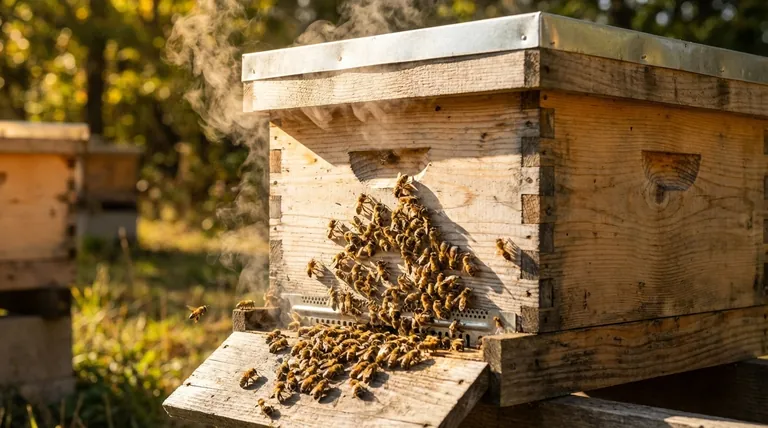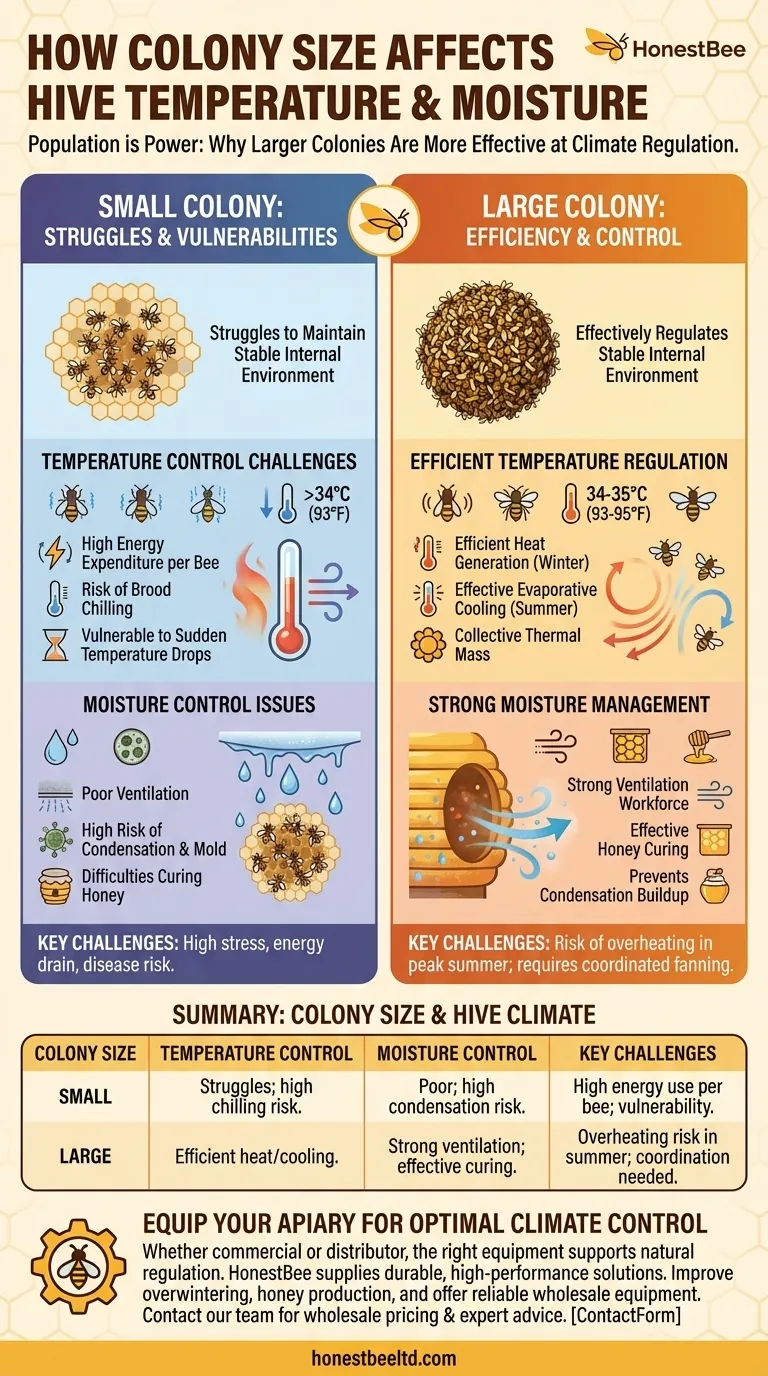In a beehive, population is power. A larger, more populous bee colony is vastly more effective at regulating both temperature and moisture than a smaller one. The sheer number of bees in a large colony provides the collective workforce needed to generate heat, create cooling airflow, and ventilate damp air, creating a stable internal environment essential for survival.
The core principle is simple: a beehive's ability to control its internal climate is directly proportional to its population. A larger workforce provides both the raw heating power for winter and the coordinated ventilation for summer cooling and moisture removal.

The Physics of Hive Thermoregulation
A honeybee colony operates as a superorganism, collectively achieving what no single bee could. This is most apparent in its ability to maintain a stable internal temperature, particularly in the brood nest, which is kept at a remarkably constant 34-35°C (93-95°F).
Heat Generation: The Thoracic Furnace
Individual worker bees generate heat by uncoupling their wings and vibrating their powerful thoracic flight muscles. This friction-based heating is the colony's furnace.
A larger population means more individual furnaces working in unison. This collective effort allows the colony to easily raise the temperature of the brood nest or the winter cluster.
The Winter Cluster: A Collective Thermal Mass
In winter, bees form a tight cluster to conserve heat. The cluster's structure is a marvel of thermal efficiency.
Bees on the outer layer, the mantle, press together to form an insulating shell that can be several inches thick. Inside this shell, bees in the core are less densely packed and actively generate heat.
A larger colony creates a larger cluster. This improves the surface-area-to-volume ratio, meaning less heat is lost per bee, making their efforts far more efficient.
Summer Cooling: The Evaporative Engine
To combat overheating, bees employ evaporative cooling. Forager bees collect water and deposit it within the hive.
House bees then fan their wings vigorously at the hive entrance and throughout the interior. This coordinated fanning creates airflow that evaporates the water, just like sweat cools your skin, effectively lowering the hive's internal temperature. More bees mean more fanning power.
How Colony Size Governs Moisture Control
Temperature is only half the battle; managing humidity is equally critical. Excess moisture, especially in cold weather, can be lethal.
The Sources of Hive Moisture
The two primary sources of moisture inside a hive are the metabolic respiration of the bees themselves and the process of curing nectar into honey. Curing involves evaporating a large amount of water from fresh nectar.
Ventilation is the Solution
A large, healthy colony has a dedicated workforce of fanner bees. By creating steady air currents, they can effectively exchange the warm, moist internal air for cooler, drier air from outside.
This constant ventilation is crucial for curing honey and preventing the buildup of harmful condensation.
The Danger of Condensation
In winter, a small colony struggles to generate enough heat to keep the upper surfaces of the hive (like the inner cover) above the dew point.
When warm, moist air from the cluster rises and hits a cold surface, it condenses into water. These cold drips falling back onto the cluster can chill and kill the bees. A larger, hotter cluster can often keep the entire cavity warm enough to prevent this.
The Challenges at Each End of the Spectrum
Both very small and very large colonies face unique climate-control challenges. Understanding these trade-offs is key to effective hive management.
The Vulnerability of a Small Colony
A small colony lives on the edge. It must expend enormous amounts of energy per bee to maintain brood temperature.
This constant thermoregulatory stress leaves it highly vulnerable to sudden temperature drops, making brood chilling a significant risk. It also lacks the workforce to effectively ventilate damp air, increasing the risk of mold and disease.
The Overheating Risk in a Large Colony
Conversely, a massive, booming colony in the heat of summer can struggle with overheating. The sheer metabolic heat produced by tens of thousands of bees can overwhelm their cooling efforts.
This requires an immense, coordinated fanning and water-foraging effort to prevent the wax combs from softening or brood from dying. Inadequate ventilation in an overcrowded hive is also a primary trigger for swarming.
Making the Right Choice for Your Goal
Your management strategy should directly address the population-dependent challenges your colony is facing.
- If your primary focus is overwintering a small or new colony: You must provide insulation and reduce the hive's internal volume to help them conserve precious heat.
- If your primary focus is managing a booming summer colony: Ensure you provide adequate ventilation and space for expansion to prevent overheating and swarming.
- If your primary focus is diagnosing a struggling hive: Assess the population size relative to the hive space, as this climate-control mismatch is often a root cause of their problems.
Ultimately, understanding the relationship between population and climate empowers you to become a proactive partner in your colony's success.
Summary Table:
| Colony Size | Temperature Control | Moisture Control | Key Challenges |
|---|---|---|---|
| Small | Struggles to maintain brood temperature (34-35°C); high risk of chilling | Poor ventilation; high risk of condensation and mold | High energy expenditure per bee; vulnerable to sudden temperature drops |
| Large | Efficient heat generation in winter; effective evaporative cooling in summer | Strong ventilation for honey curing and moisture removal | Risk of overheating in summer; requires coordinated fanning effort |
Equip Your Apiary for Optimal Climate Control
Whether you manage a few hives or run a large commercial apiary, the right equipment is essential for supporting your bees' natural climate regulation. HONESTBEE supplies durable, high-performance beekeeping supplies and equipment designed to help colonies of all sizes thrive.
- For Commercial Apiaries: Improve overwintering success and summer honey production with our ventilated hive boxes and insulating materials.
- For Beekeeping Equipment Distributors: Offer your customers reliable wholesale equipment that addresses the specific challenges of colony size.
Let's discuss how our solutions can support your beekeeping goals. Contact our team today for wholesale pricing and expert advice.
Visual Guide

Related Products
- Wholesales Dadant Size Wooden Bee Hives for Beekeeping
- HONESTBEE Advanced Ergonomic Stainless Steel Hive Tool for Beekeeping
- Professional Galvanized Hive Strap with Secure Locking Buckle for Beekeeping
- Professional Engraved Round Hive Number Tags for Beekeeping
- Long Langstroth Style Horizontal Top Bar Hive for Wholesale
People Also Ask
- What is the best place to keep bees? Find the Perfect Apiary Site for Your Hives
- What are the characteristics of oil-based paint for beehives? Durability vs. Modern Practicality
- What should beginners consider when purchasing beekeeping equipment? A Guide to Essential Starter Gear
- How often should the area under beehives be inspected and cleaned during the warm season? A Proactive Maintenance Guide
- What are the advantages of wooden bee hives? Superior Bee Health & Beekeeper Flexibility



















